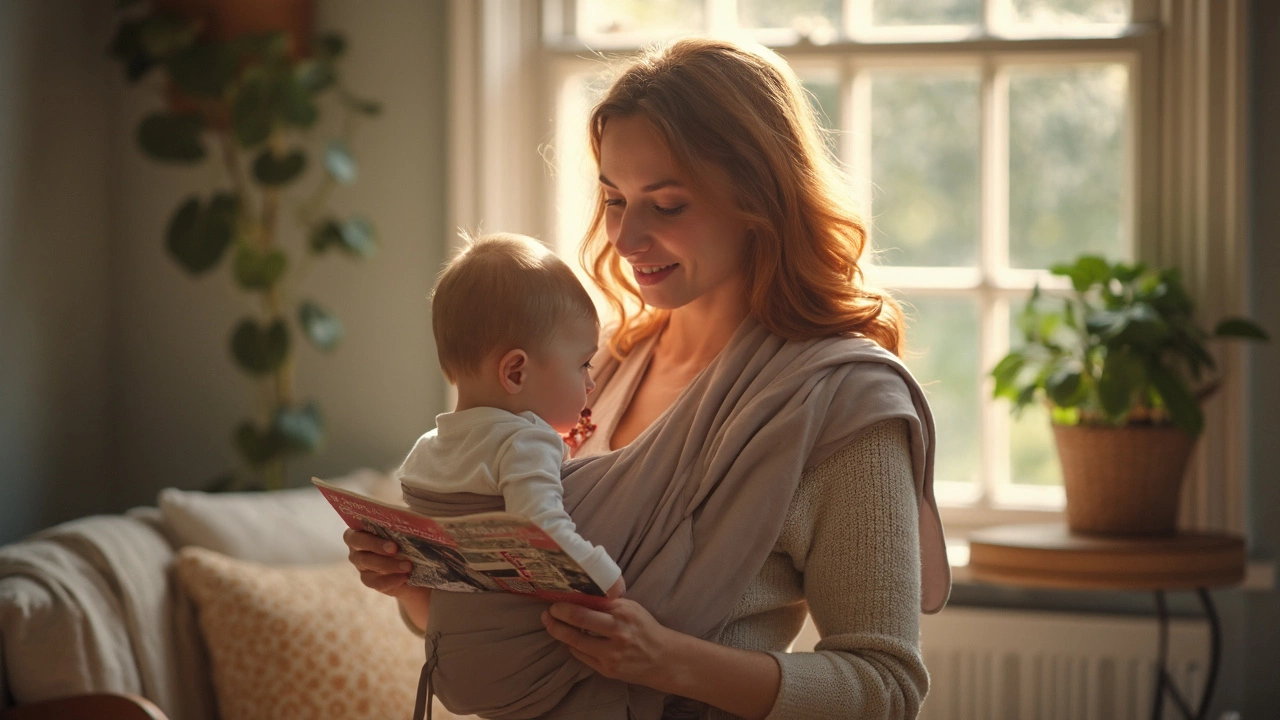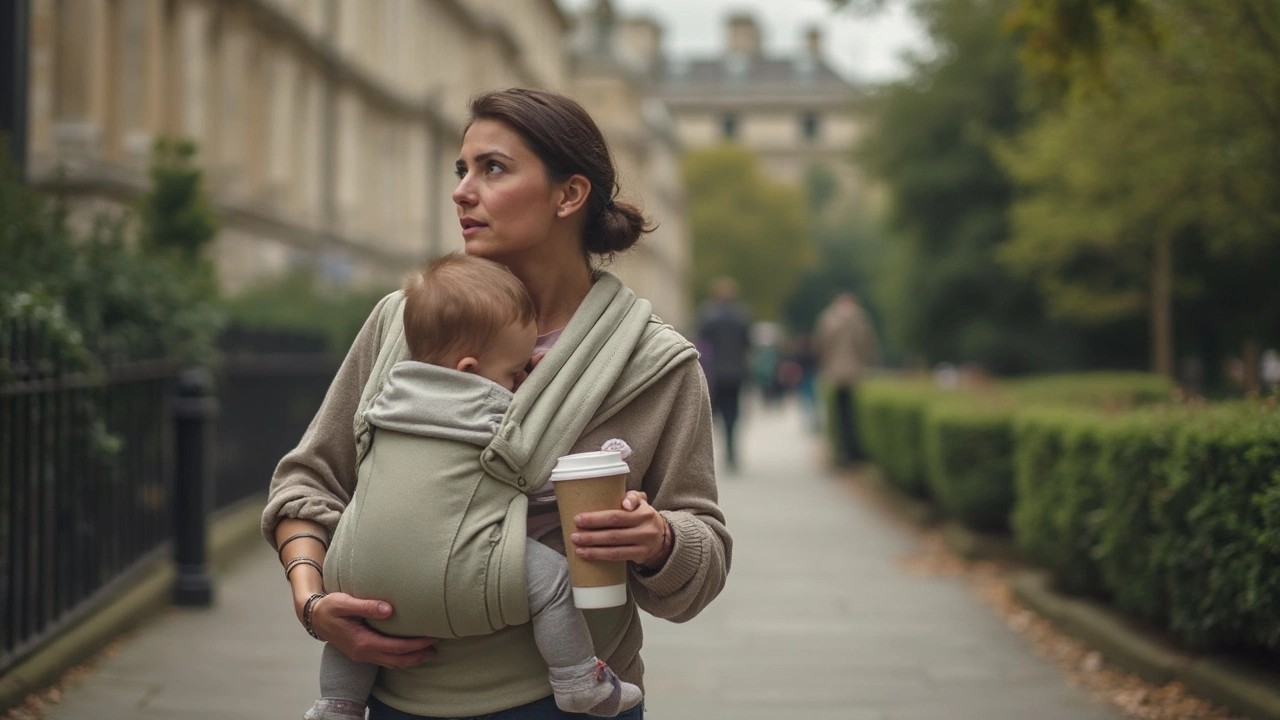Is Baby Sling Bad for Baby's Spine? Unpacking the Facts

Baby slings look so simple, but if you’re like most parents, you’ve probably wondered—is it safe for my baby’s spine? This isn’t just a random worry. You want to do everything right, especially when it comes to your baby’s bones and growth. The truth? It depends on how you use the sling and the style you pick.
Let’s get one thing out of the way: a baby’s spine is flexible and still developing for years after birth. Support is key. That’s why you’ll hear about the “M position” or “froggy position,” where the baby’s knees are higher than their bottom and hips are spread open. This posture doesn’t just look cute—it helps keep the hip joints and spine in a natural, safe alignment.
Not all slings are made the same. Some are soft and stretchy, hugging your baby’s body, while others are firmer. Whichever type you choose, their back should never be stiff or flat against your body. Watch for signs of slumping, and always make sure your baby’s face isn’t pressed in weird angles or covered by fabric.
- How Baby Slings Affect Baby's Spine
- Expert Opinions and Research
- Safe Babywearing: What to Look For
- Tips for Comfortable and Healthy Baby Sling Use
How Baby Slings Affect Baby's Spine
Worried about your baby's backbone? You’re not the only one. The biggest concern with baby slings centers on whether they help or hurt a baby’s developing spine. Newborns and young infants have a natural curve in their backs—imagine a gentle "C" shape. It’s super important their back doesn’t get forced straight too early because their muscles and bones are still growing and gaining strength.
Most health professionals agree that when a sling puts your baby in a "spread squat" or "M position," it works with your baby’s body, not against it. This means baby’s knees should be up, hips open, and the spine slightly rounded, especially if they’re under six months old.
But the risk comes when babies slump down in a sling, get bunched up, or are carried facing out too soon. These positions can pull on their spine in ways that aren’t natural, increasing the chance of discomfort or, rare but possible, hip issues. The right support makes a big difference, especially in the early months.
- Too-straight posture can overwork their back and hip joints.
- A deep seated squatting position supports hip and spine growth.
- Loose or baggy slings can lead to slumping—this can put a strain on their back and even affect breathing.
You might be surprised, but a 2022 German study reported that babies in a baby sling, with good ergonomic support, actually had less spinal and hip stress than those left lounging in some baby bouncer seats or car seats for hours at a stretch.
| Position | Spine Support | Risk Level |
|---|---|---|
| M Position | Excellent | Low |
| Facing Out (early age) | Poor | High |
| Tightly Curled (slumped) | Poor | High |
| Flat Back/Overstretched | Poor | Medium |
Bottom line: the way you use the sling means everything for your baby’s spine. The gear is just the start—the position matters way more.
Expert Opinions and Research
Pediatricians and physical therapists have weighed in on the safety of baby sling use, especially when it comes to babies’ spines and hips. Most agree that when slings are used properly, there’s no increased risk to the spine. But improper carrying—for example, letting a baby slump or hang with their legs straight—can stress both the spine and hip joints.
The International Hip Dysplasia Institute has spoken up about baby carriers and slings. They recommend using carriers that put your baby in that famous “M position” for the best spine and hip development. In fact, their research says that the healthy development of the hip socket really depends on keeping the thighs supported and separated. This reduces the chance of hip dysplasia, a condition where the hip joint doesn’t form correctly.
| Study/Organization | Main Finding |
|---|---|
| International Hip Dysplasia Institute (2022) | Sling use supports natural hip and spine development if positioned properly |
| Canadian Paediatric Society (2021) | Approved slings are safe for spinal growth; caution with unsupported, slumped posture |
| American Academy of Pediatrics | Parent awareness and correct technique lower spine or airway risks in slings |
According to a 2021 update from the Canadian Paediatric Society, slings and soft-structured carriers are safe for spinal growth as long as you avoid positions where the back is rigid or baby’s chin is pressed to the chest. This is also echoed by the American Academy of Pediatrics, which points out that parent awareness and technique matter more than the brand of sling.
- Always make sure your baby is upright and supported from knee to knee.
- Check that your baby’s face stays in view and their airway is clear.
- Double check for natural curves in the back, not a forced straight line, especially for newborns and younger infants.
Bottom line: research and professionals agree—sling use itself isn’t dangerous, but the way you position your baby and the style of carrier makes all the difference.

Safe Babywearing: What to Look For
Picking the right sling isn't just about pretty prints or trends. For your baby's spine and safety, you want to zero in on a few basics. Before buying, check the weight and age guidelines—newborns and bigger babies need different kinds of support. If you're using a sling for a baby under four months, make sure it's not too loose, since floppy slings can let them slump into a risky position.
The "M" position matters most. Your baby's knees should be up and the legs spread wide, like a squat. The spine should curve naturally, not forced flat. Some slings have structured seats or "pouches" that make this easy without tons of adjusting. Always check that your baby’s chin is off the chest with clear airflow—babies can get into trouble quickly if their face is pressed down.
Look for slings certified by safety groups. For example, in the US, the ASTM and JPMA marks are signs the carrier met safety checks. In the UK or Europe, check for EN 13209 or CEN/TR 16512 numbers on packaging. Here’s a quick comparison of common sling types and what they offer for baby sling safety:
| Type | Best For | Spine & Hip Support | Downside |
|---|---|---|---|
| Ring Sling | Newborns+ | Good if tightened properly | Can slip if not well-adjusted |
| Stretchy Wrap | Newborns only | Excellent for little babies | Sags with heavier weight |
| Mei Tai/Soft Structured | Infants to toddlers | Often has built-in seat for hips | Needs good fit for small babies |
| Pouch Sling | Quick up-and-down use | Okay if snug, less adjustable | Tricky to size for caregivers |
Try the T.I.C.K.S. rule for extra safety:
- Tight: Baby needs to be held snug and high on your chest.
- In view: Always see their face.
- Close enough to kiss: You should be able to kiss the top of their head.
- Keep chin off chest: Airway should always be clear.
- Supported back: Keep the spine in a natural curve with their tummy facing you.
If your sling gets worn out, stretched, or the seams look funny, swap it out. It’s just not worth the risk. And if you're ever unsure, lots of areas have babywearing groups—parents swap tips, and certified consultants double-check your setup. Getting it checked, even once, can make a real difference for peace of mind.
Tips for Comfortable and Healthy Baby Sling Use
Worried about picking the right sling or getting the fit just right? You’re not alone! Small adjustments make all the difference between a snug, safe ride and an awkward, unsafe one—especially for your baby’s growing spine.
First, always check your sling’s instructions. They’re there for a reason. Manufacturers test these for weight limits, carry positions, and fabric safety. If something isn’t clear or feels off, search for official online videos from the brand, or ask for help in local babywearing groups—many parents love to show you the ropes in person.
Here are some tried-and-true ways to keep things comfy and support your baby’s body:
- Make sure your baby is close enough to kiss. This means their head is high on your chest, so you can check on them by just tipping your chin down.
- Keep the spine naturally curved in a gentle "C" shape, not forced straight or slumped.
- Check that the "M position" is in play: baby’s knees should be level with or higher than their hips.
- The sling fabric should support your baby's entire back and neck, especially for newborns who can’t hold their own head up yet.
- Regularly check airways. Always see your baby’s face, and don’t let any fabric cover their nose or mouth.
- Switch carrying sides as your baby grows to balance out muscle use for both you and your baby.
Want some numbers? Here’s what makes a real difference when it comes to using a baby sling safely and comfortably:
| Age | Carries Best For | Recommended Time in Sling (per session) |
|---|---|---|
| 0-3 months | Front, facing in | Up to 1 hour |
| 3-6 months | Front, facing in or out | 1-2 hours |
| 6-12 months | Front or hip carry | 2+ hours if comfy |
Frequent wiggle checks are smart. Babies change positions—a lot. If you notice your baby slumping, fussing, or looking uncomfortable, readjust sooner rather than later. Little things, like using a mirror to check your back carry, can make all the difference.
Last thing: if you ever feel unsure, tap into in-person resources. Hospitals, parent support groups, or local baby stores often offer babywearing workshops. Seeing a demo or getting hands-on help is the fastest way to boost your confidence and rock that sling safely.


